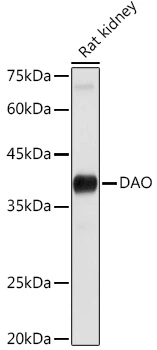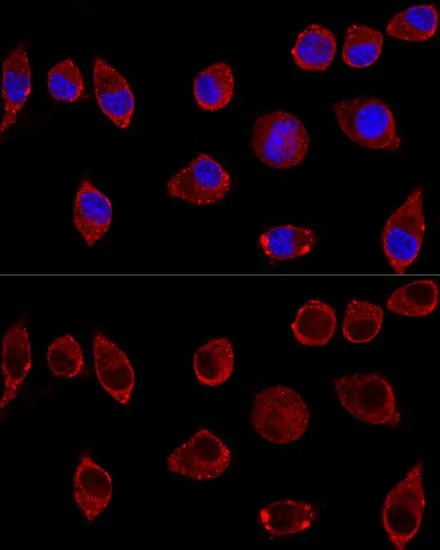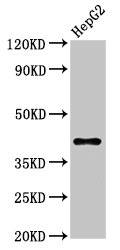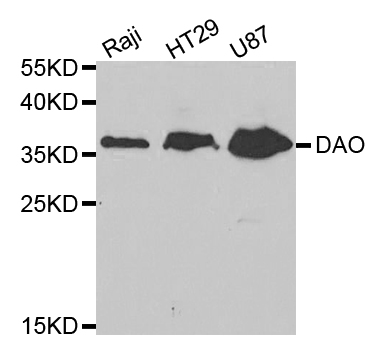
WB analysis of rat kidney tissue lysate using GTX53998 DAO antibody. Dilution : 1:3000 Loading : 25microg per lane
DAO antibody
GTX53998
ApplicationsImmunoFluorescence, Western Blot, ImmunoCytoChemistry
Product group Antibodies
TargetDAO
Overview
- SupplierGeneTex
- Product NameDAO antibody
- Delivery Days Customer7
- Application Supplier NoteWB: 1:500 - 1:2000. ICC/IF: 1:50 - 1:200. *Optimal dilutions/concentrations should be determined by the researcher.Not tested in other applications.
- ApplicationsImmunoFluorescence, Western Blot, ImmunoCytoChemistry
- CertificationResearch Use Only
- ClonalityPolyclonal
- ConjugateUnconjugated
- Gene ID1610
- Target nameDAO
- Target descriptionD-amino acid oxidase
- Target synonymsDAAO, DAMOX, OXDA, D-amino-acid oxidase
- HostRabbit
- IsotypeIgG
- Protein IDP14920
- Protein NameD-amino-acid oxidase
- Scientific DescriptionThis gene encodes the peroxisomal enzyme D-amino acid oxidase. The enzyme is a flavoprotein which uses flavin adenine dinucleotide (FAD) as its prosthetic group. Its substrates include a wide variety of D-amino acids, but it is inactive on the naturally occurring L-amino acids. Its biological function is not known; it may act as a detoxifying agent which removes D-amino acids that accumulate during aging. In mice, it degrades D-serine, a co-agonist of the NMDA receptor. This gene may play a role in the pathophysiology of schizophrenia. [provided by RefSeq, Jul 2008]
- Storage Instruction-20°C or -80°C,2°C to 8°C
- UNSPSC12352203
References
- Ueda E, Ohta T, Konno A, et al. D-Cysteine Activates Chaperone-Mediated Autophagy in Cerebellar Purkinje Cells via the Generation of Hydrogen Sulfide and Nrf2 Activation. Cells. 2022,11(7). doi: 10.3390/cells11071230Read this paper
- Ohta T, Morikawa Y, Sato M, et al. Therapeutic potential of d-cysteine against in vitro and in vivo models of spinocerebellar ataxia. Exp Neurol. 2021,343:113791. doi: 10.1016/j.expneurol.2021.113791Read this paper








